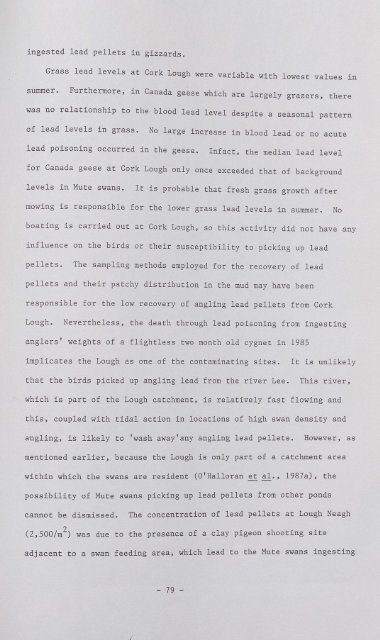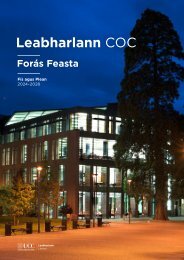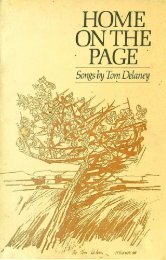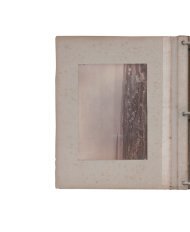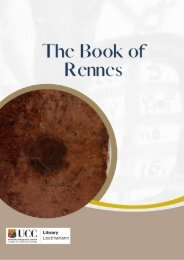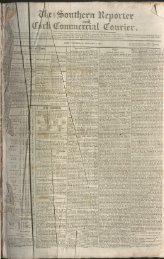Lead Toxicity in Mute Swans
LEAD TOXICITY IN MUTE SWANS Cygnus olor (Gmelin). By JOHN O'HALLORAN A thesis submitted to the National University of Ireland in candidature for the degree of Doctor of Philosophy September 1987
LEAD TOXICITY IN MUTE SWANS
Cygnus olor (Gmelin).
By
JOHN O'HALLORAN
A thesis submitted to the National University of Ireland
in candidature for the degree of Doctor of Philosophy
September 1987
You also want an ePaper? Increase the reach of your titles
YUMPU automatically turns print PDFs into web optimized ePapers that Google loves.
I<br />
<strong>in</strong>gested lead pellets <strong>in</strong> gizzards.<br />
Grass lead levels at Cork Lough were variable with lowest values <strong>in</strong><br />
summer.<br />
Furthermore, <strong>in</strong> Canada geese which are largely grazers, there<br />
was no relationship to the blood lead level despite a seasonal pattern<br />
of lead levels <strong>in</strong> grass.<br />
No large <strong>in</strong>crease <strong>in</strong> blood lead or no acute<br />
lead poison<strong>in</strong>g occurred <strong>in</strong> the geese.<br />
Infact, the median lead level<br />
for Canada geese at Cork Lough only once exceeded that of background<br />
levels <strong>in</strong> <strong>Mute</strong> swans.<br />
It is probable that fresh grass growth after<br />
mow<strong>in</strong>g is responsible for the lower grass lead levels <strong>in</strong> summer.<br />
No<br />
boat<strong>in</strong>g is carried out at Cork Lough, so this activity did not have any<br />
<strong>in</strong>fluence on the birds or their susceptibility to pick<strong>in</strong>g up lead<br />
pellets. The sampl<strong>in</strong>g methods employed for the recovery of lead<br />
pellets and their patchy distribution <strong>in</strong> the mud may have been<br />
responsible for the low recovery of angl<strong>in</strong>g lead pellets from Cork<br />
Lough.<br />
Nevertheless, the death through lead poison<strong>in</strong>g from <strong>in</strong>gest<strong>in</strong>g<br />
anglers' weights of a flightless two month old cygnet <strong>in</strong> 1985<br />
implicates the Lough as one of the contam<strong>in</strong>at<strong>in</strong>g sites. It is unlikely<br />
that the birds picked up angl<strong>in</strong>g lead from the river Lee.<br />
This river,<br />
which is part of the Lough catchment, is relatively fast flow<strong>in</strong>g and<br />
this, coupled with tidal action <strong>in</strong> locations of high swan density and<br />
angl<strong>in</strong>g, is likely to 'wash away'any angl<strong>in</strong>g lead pellets. However, as<br />
mentioned earlier, because the Lough is only part of a catchment area<br />
with<strong>in</strong> which the swans are resident (O'Halloran et al., 1987a), the<br />
possibility of <strong>Mute</strong> swans pick<strong>in</strong>g up lead pellets from other ponds<br />
cannot be dismissed.<br />
The concentration of lead pellets at Lough Neagh<br />
(2,500/m 2 ) was due to the presence of a clay pigeon shoot<strong>in</strong>g site<br />
adjacent to a swan feed<strong>in</strong>g area, which lead to the <strong>Mute</strong> swans <strong>in</strong>gest<strong>in</strong>g<br />
- 79 -


